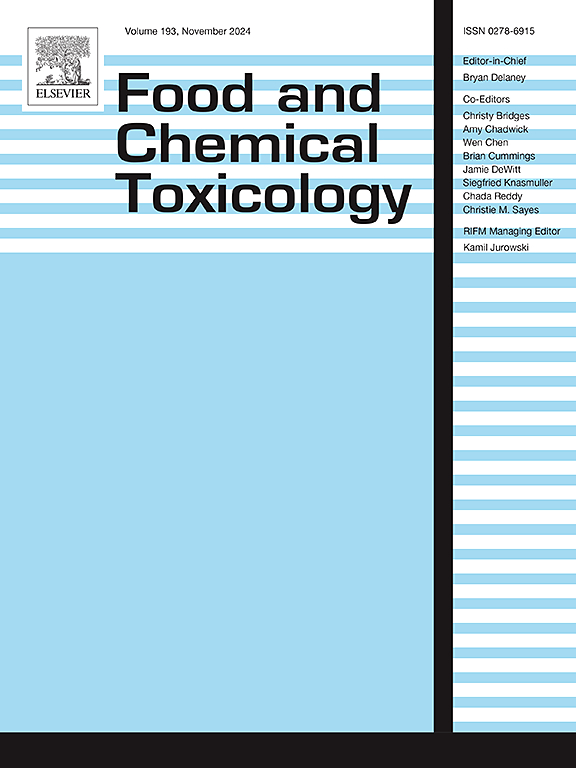Stochastic health risk assessment of aflatoxin M1 in cow's milk among Lebanese population
IF 3.9
3区 医学
Q2 FOOD SCIENCE & TECHNOLOGY
引用次数: 0
Abstract
This study quantitatively assessed AFM1 exposure through consumption of cows' milk in Lebanese adolescents and adults. Lebanon-specific, non-aggregated data on (i) milk intake and body weight – from an existing survey for adults and from a new survey for adolescents, and (ii) AFM1 occurrence in milk, were fitted to distributions and incorporated into a probabilistic model. Risk of hepatocellular carcinoma (HCC) for milk consumers was estimated considering the incidence of hepatitis B virus in Lebanon and characterized using the margin of exposure (MOE). All subgroups’ mean risk estimates, expressed as additional HCC cases per 100 000 population per year, were significantly different (p < 0.05), and ranged from 2.2x10−4 for adult males to 4.9x10−4 for adolescent males. This variation is attributed to significant differences in body weight and milk intake. MOE identified adolescent males and females as at-risk populations (mean 9628 and 8108, respectively). For adults, levels of concern were only reached with extreme consumption and/or contamination events. Considering that exposure from other sources (e.g., dairy) is cumulative, control of AFM1 in milk in Lebanon should be a risk management priority to ensure protection of younger populations.
黎巴嫩人口牛奶中黄曲霉毒素 M1 的随机健康风险评估
本研究定量评估了黎巴嫩青少年和成年人通过饮用牛奶接触 AFM1 的情况。针对黎巴嫩的非汇总数据包括:(i) 牛奶摄入量和体重(来自现有的成人调查和新的青少年调查);(ii) 牛奶中的 AFM1 含量,这些数据被拟合成分布并纳入概率模型。考虑到黎巴嫩乙型肝炎病毒的发病率,对牛奶消费者罹患肝细胞癌(HCC)的风险进行了估算,并使用暴露限值(MOE)对风险进行了描述。所有亚组的平均风险估计值(表示为每年每 10 万人口中新增的 HCC 病例)均有显著差异(p < 0.05),从成年男性的 2.2x10-4 到青少年男性的 4.9x10-4。这种差异归因于体重和牛奶摄入量的显著差异。教育部将青少年男性和女性确定为高危人群(平均值分别为 9628 和 8108)。对于成年人来说,只有在极端消费和/或污染事件中才会达到关注水平。考虑到其他来源(如乳制品)的暴露是累积性的,因此控制黎巴嫩牛奶中的 AFM1 应成为风险管理的优先事项,以确保保护年轻人群。
本文章由计算机程序翻译,如有差异,请以英文原文为准。
求助全文
约1分钟内获得全文
求助全文
来源期刊

Food and Chemical Toxicology
工程技术-毒理学
CiteScore
10.90
自引率
4.70%
发文量
651
审稿时长
31 days
期刊介绍:
Food and Chemical Toxicology (FCT), an internationally renowned journal, that publishes original research articles and reviews on toxic effects, in animals and humans, of natural or synthetic chemicals occurring in the human environment with particular emphasis on food, drugs, and chemicals, including agricultural and industrial safety, and consumer product safety. Areas such as safety evaluation of novel foods and ingredients, biotechnologically-derived products, and nanomaterials are included in the scope of the journal. FCT also encourages submission of papers on inter-relationships between nutrition and toxicology and on in vitro techniques, particularly those fostering the 3 Rs.
The principal aim of the journal is to publish high impact, scholarly work and to serve as a multidisciplinary forum for research in toxicology. Papers submitted will be judged on the basis of scientific originality and contribution to the field, quality and subject matter. Studies should address at least one of the following:
-Adverse physiological/biochemical, or pathological changes induced by specific defined substances
-New techniques for assessing potential toxicity, including molecular biology
-Mechanisms underlying toxic phenomena
-Toxicological examinations of specific chemicals or consumer products, both those showing adverse effects and those demonstrating safety, that meet current standards of scientific acceptability.
Authors must clearly and briefly identify what novel toxic effect (s) or toxic mechanism (s) of the chemical are being reported and what their significance is in the abstract. Furthermore, sufficient doses should be included in order to provide information on NOAEL/LOAEL values.
 求助内容:
求助内容: 应助结果提醒方式:
应助结果提醒方式:


